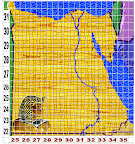STANDARDS FOR EGYPTOLOGY RESEARCH
=============================How many thousands of researchers will repeat the same research over and over and over.
Wasting their resources to find that which is already found and available.?
In order to sort out endless mis-understandings / confusion:
An International Egyptology Standard
would expedite the needs for all Egyptology researchers to find existing information and to publish their own new information so it can be shared with the world.
=============================
In order for people using different standards to work with other standards, they must use conversion.
In the field of Egyptology there are so many different standards in different phases, it is chaos.
Cubits, Feet, Meters
Celsius, Fahrenheit, Kelvin
Acres, Hectares
The reason why carpenters can go into a house built years ago and find, fix or add new structures is the standards created.The reason you can go to the store and get plumbing parts to replace your own, is because of parts being made with standard measurements.
When there are optional elements instead of a standard, the flow of information is hampered.
=============================
I would suggest a university in Egypt for the hub of An International Egyptology Standard organization.
Working with other universities around the world, to create an international standard that Egyptologist around the world would base their research on.
=============================
a) Multiple spellings of the same name
b) Different spellings for the same person
c) Different Egyptians with the same names
a) When there are multiple spellings, the standard organization would pick which is the standard
b) When there are different spellings for the same person, the organization would pick the standard.
=============================
, automobile, motor vehicle, alternate, alternate
car
standard
=============================
By the creation of an Egyptologist spell checker, any one could use their own word processor and dump their file in the program.
When the word processor encountered an alternate spelling, it would be replaces with the standard.
The man drove his automobile to the next down
would become
The man drove his § car to the next down.
There could be a standard symbol { § what ever} to note the word was replaced with the standard.
=============================
c) When there were more than one Egyptian with the same spelling { Ahmose King/Military man), an alternate name would be assigned as the standard to one of them.
When the spell checker encountered a name that could be two different people, it would pause for the correction
Ahmose the King
Ahmose the military commander.
Just like a regular spell checker you would click on the correct choice.
=============================
PLACES WITH DIFFERENT SPELLINGS OR DIFFERENT NAMES
Not only are the same place given different names or different spellings, but there are also different places with the same names.The spell checker would perform the same task, replacing alternate spellings with the standard and pausing to allow the author to chose the correct place when two places have the same names.
With this Egyptologist spell checker, it could also add other information to the places.
Information that would take hours in a large text to enter, would be done with the spell checker.
When ever the spell checker encountered the standard or alternate spelling of a place, it would create roll over text giving the global position of that place.
[ Roll over text = text that appears when you place the mouse over a word ]
=============================
STANDARD MAP
Any one who has ever created maps, knows if you try to draw all the detail of lots of places, the text gets so small, it can not be read.The map I suggest begins with an outline of Egypt with the major locations on it. With pixels representing a particular global position.
When the spell checker created the standard for a place on the map, that place would become a link.
If that link was clicked on, the map would appear with that place in Egypt would appear.
=============================
When future publishers created books ... when professors taught Egyptology, the standard spellings would be taught.
=============================
STANDARD GLYPHS
There are people downloading font software and creating fonts for glyphs daily. By the creation of standard glyphs, made public domain, by all researchers using the same glyph fonts, their hard copies could use finger print technology to be read and the typed text could create a universal ASCII code that could be shared in a common data base.To get from hieroglyphics to translations, the standard would be created first by transcribing existing hieroglyphics to a computer file.
Once any hieroglyphic had been transcribed, future researchers would not have to view poorly photographed images in an attempt to even figure out which glyphs were on the actual source.
I recently asked about one hieroglyphic source that people are talking about all over the internet. When I finally found some who knew where the source was, they said you could no longer make out the writing.
It appears that most 'Egyptologist' go to tombs or such locations and pick a small area of interest. Before they vanish, it is essential for every remaining hieroglyphic source to be photographed in high definition, or it will be lost forever.
=============================
The Egyptologist standard dictionary I suggest would
* Replace all alternate persons names with the standard
* Give the option of which person it was when more than one person had the same name.
* Replace alternate place names with the standard, give the location of that place in a roll over text.
All of this (and more) could be done after any author finished their work, by simply pasting their text into the dictionary program.
=============================
Below are two working examples. By moving the cursor over the purple/yellow icon, you can see the text.
The Crew Commander
you, all people.
King Tuts' tomb is in
It is the same icon but the bottom displays text and can take you to a map.
~
zendz

No comments:
Post a Comment